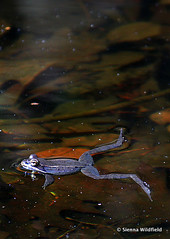The Ripple: The Magic of Spring Peepers. The Science of Vernal Pools
How do spring peepers know when to start singing?

Vernal pools contain creatures (amphibians and bugs) that can only breed where there are no hungry fish. Citizen scientists are needed to find and report vernal pools in the Hilltowns. (Photo credit: Sienna Wildfield)
How do spring peepers know when to start singing?
They don’t have weather reports, or the ability to see the buds forming on trees, the snow melting, or teens walking around in shorts and T’s when it’s 40 degrees and climbing.
Certainly, there are scientific reasons that explain how peepers know when to announce the return of the sun and the warmth; but there’s a simpler reason that is worth considering and appreciating. The peepers feel the right moment to sing.
Peepers are a special family of frogs, and frogs have a unique physiology—a evapotranspirative skin that makes them especially sensitive to the slightest changes in temperature, humidity, chemistry and other things we don’t have words for including that feeling that we also get when spring arrives. There is, for example, a new kind of sunlight that appears out of the grey, slush and slog of the late winter months that Emily Dickinson noticed, and maybe you and the peepers notice too.
Science might tell us the story of how the nervous systems of the peepers intuit and react to the thermonuclear/electromagnetic surge that accompanies our spring equinox, the day the sun’s rays hit the equator straight on. But can science explain why, in coincidence with the celestial flicking on of the peeper song -switch, major religions have their own switches flicked on—in the form of Passover, Easter & Holi?
Of all the neighbors we have, the peepers are the loudest and most boisterous announcers of spring; and have you noticed that, though they are so loud, their sound is not noisy? Somewhere deep inside us, their petite buglings find sympathy: and, here, “sympathy” means “the correlation existing between bodies capable of communicating their vibrational energy to one another through some medium.”
Perhaps you have been so drawn to the song of the peepers that you have tried to track them down. And what did you find when you tried that? Something very magical, and also perplexing—silence.
How do they know you are near? Vibrational energy: your footsteps quaking the earth, sending the same kind signal you see when you throw a rock into still water.
Like all frogs, peepers are living dinosaurs who, despite their lack of armor, claws and sharp teeth, have survived for plus or minus 300 million years. Their evolutionary success is due to their extreme sensitivities, not their ruthless might. For us, who have a history that begins about 5,000 years ago (and a prehistory that begins about 65 million years ago), this ought to be a lesson.
At the very least, this lesson includes the fact that we miss—through ignore-ance, distraction and abstraction—so much that is actual. As actual as the different sunlights of each season, and the sympathy religious holidays have with the song of the peepers. And the feeling we have that somehow, the peepers sing our song, too.
Since you can’t get close to peepers, and I want you to get as close to Spring as possible, here’s an actuality you must not miss this year—the vivification of vernal pools. These pools contain creatures (amphibians and bugs) that can only breed where there are no hungry fish; tiny clams and shrimps also live in them, that got marooned when the tectonic plates shifted and lifted their habitats high and dry into what is now the Hilltowns. Like the peepers, they are teachers whose lessons we have much to learn from.
Instead of describing what these are, I’ll send you to these links so you can investigate them yourselves. Here’s the basic Mass DEP page. You’ll notice on this page that the DEP needs citizen scientists to find vernal pools, so that these rare habitats and creatures can be preserved.
If you look at the DEP map and select in “available data layers” the folder “Natural Heritage Data” and, in that folder, “NHESP Certified Vernal Pools,” you’ll see all the vernal pools that have been listed for protection by the DEP.
Zoom in on your town, and you might find some near you—if so, please put on your walking shoes and go find one of them. You might not find any listed where you live; that doesn’t mean they aren’t actually there; it just means that nobody has tried to find and list them yet. Most of the Hilltowns have few or no listings—which means that citizen scientists have a lot of good work to do.
The song of the peepers announces Spring, and sounds an invitation to discover the soft, awesome, perennial powers of biotic integrity and resilience.
 ABOUT THE AUTHOR
ABOUT THE AUTHOR
Kurt Heidinger, Ph.D. is the Executive Director of Biocitizen, non-profit school of field environmental philosophy, based in the Western MA Hilltown of Westhampton, MA where he lives with his family. Biocitizen gives participants an opportunity to “think outside” and cultivate a joyous and empowering biocultural awareness of where we live and who we are. Check out Kurt’s monthly column, The Ripple, here on Hilltown Families on the 4th Monday of every month to hear his stories about rivers in our region. Make the world of rivers bigger than the world of pavement inside of you!
 Hilltown Families
Hilltown Families 





























